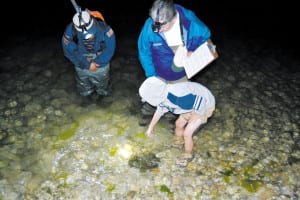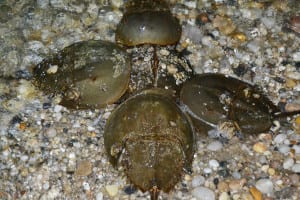By Mallie Jane Kim
In the thick mud of low tide at Setauket’s Shore Road Marina, volunteers and scientists in knee-high rubber boots dumped out a jumble of shells along the shoreline — each with larval oysters attached, ready to grow and help eventually filter the water.

This Nov. 25 “oyster planting” was part of a partnership between volunteer organization Setauket Harbor Task Force, which monitors area water quality, and the Cornell Cooperative Extension’s marine program. The planting of about 16,000 larval oysters was funded as part of an $80,000 water quality grant secured in 2022 through the effort of Suffolk County Legislator Steve Englebright (D-Setauket) during his time in the state assembly.
“We’re making the harbor clean today,” Englebright quipped during the event. “We’re taking the credit, but the oysters are doing all the work.”
Oysters filter feed, removing nitrogen and other harmful elements from the water, either consuming them or binding them into the mud. An adult oyster can filter as much as 50 gallons of water a day, according to the Chesapeake Bay Foundation.
The larval oysters planted in Setauket Harbor are about six months old and were procured by researchers from the Cornell Cooperative. The hope is that the shellfish will grow and spawn, eventually creating an oyster reef with critical mass that can help improve water quality. Marina owners Seth Walker and Mallory Guerin, who opened their shoreline to welcome this project, are also allowing the group to set up an oyster garden on a floating dock in 2025.
“This is a really important educational thing for the community,” said Matt Sclafani, the Cornell Cooperative senior extension resource educator. “When you get a community invested in it, then that increases ownership, and you get more people lobbying for things. Then you can have a bigger plan to improve the water quality.”
But oysters are only one step in the process of cleaning water.
Sclafani explained that a comprehensive water quality improvement plan must include reducing stormwater runoff as well as improving sanitation systems over the currently prevalent cesspools.
“The oysters can’t do it on their own,” Sclafani said. “It’s a big picture, it’s a complex picture, but it starts here.”

New York voters in November approved a proposition to add a .125% sales tax increase toward funding new sewers and replacing aging cesspools. According to the proposition, there are currently 209,000 cesspools in “environmentally sensitive areas” of Suffolk County. Additionally, the Town of Brookhaven in 2023 installed a drainage system along Route 25A in Setauket to help decrease the stormwater that was previously running straight into the harbor.
The town was also instrumental in the oyster-planting process. Town Councilmember Jonathan Kornreich (D-Stony Brook) led the council in designating the area as a management district, allowing the initiative to move forward with minimal bureaucracy since the work is intended to improve environmental conditions.
Setauket Harbor has long been restricted from shellfish harvesting because of unhealthy water quality and bacteria.
“This is one piece of a bigger puzzle for us, basically just trying to be stewards of these waters,” Kornreich said at the event. “It’s a full spectrum approach to trying to improve water quality, and shellfish mariculture is a really important piece of it.”







